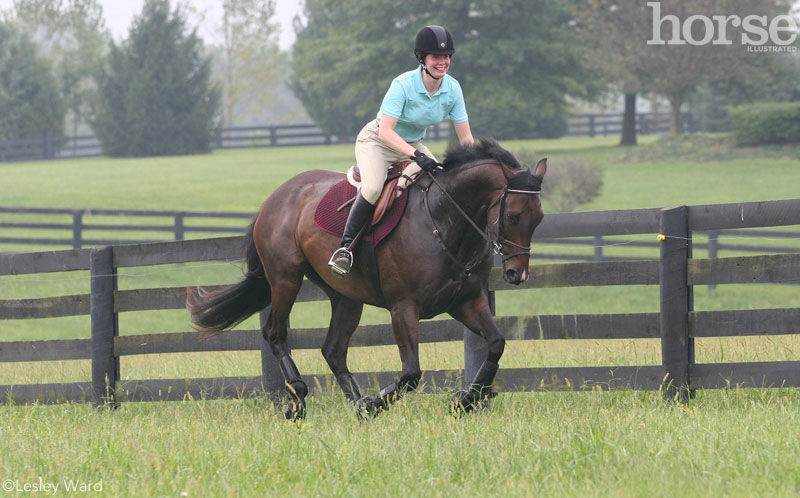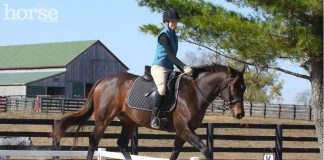In the wild, a band of horses will travel far distances each day in search of forage and water. It is not uncommon for wild horse herds to range 10 to 20 miles in a day. But what happens when we take our normally sedentary, domesticated horses out of a small pasture or paddock confinement and attempt to put them to work in athletic sports? The situation becomes more complex. For one, a horse in athletic pursuits is usually asked to move out at a faster and more consistent pace than what he might select given his own options, and he must carry your weight on his back during these exertions.

Response of Different Organ Systems
A young horse entering his first athletic season responds well to a proper conditioning program, as his tissues are still growing and developing. If you are converting a horse from another sport to your desired pursuit, then you start with an advantage: His athletic body has already been primed to respond to the conditioning process. The skill and demands of a new sport may be different, but the horse’s metabolic and physical components have been “programmed” to some degree. On the other hand, a mature horse that has not participated in strenuous athletics in his lifetime may never fully develop his genetic potential. Those tissues may have lost some inherent ability to respond to conditioning, and the strategy used will be similar to that applied to a young, previously non-athletic horse. However, you can expect the process to take longer for an idle horse than for a young or already-working horse.
As you consider the pace and progress of your horse’s fitness program, keep in mind that tissues with the greatest blood supply respond most quickly to conditioning. Skin, muscles, the lungs and heart possess an excellent blood supply, responding to cardiovascular training within three to six months. Enzyme systems and blood circulation improve rapidly in muscles, while skin capillaries develop to assist in body cooling.
Support tissues like ligaments, tendons and joint capsules are relatively poorly supplied with blood, so preparation of these tissues requires at least six to 12 months. If you ask your horse for too much work or speed on under-developed support tissues, you may see signs of excess stress, such as filling along the tendons, swelling in the tendon sheaths or joints, and possibly lameness.
Bone requires the longest period of time to develop to full density and strength. You should expect conditioning of bone to take one to two years. To fully develop a young horse or an idle, mature horse, you may need as long as three years before you might expect him to be extremely competitive in rigorous events. However, an already well-developed athletic horse may be safely conditioned for any competition within three to six months assuming the horse has suffered no previous injuries.
Starting a Conditioning Program
Before you start in with an exercise program, you’ll want to attend to basic maintenance needs, fine-tuning where necessary. Make sure your horse’s hooves receive balanced trims and are correctly shod. Discuss dietary needs, routine parasite control and vaccination measures with your vet. Have your vet address dental needs, like floating. If wolf teeth are present on a young horse, have them pulled. Check your saddle fit to ensure the saddle won’t create back soreness. You’ll get the best performance from your horse if he’s healthy and feels comfortable, and has energy resources to draw from.
As you plan your riding strategy, your aim is to develop a solid foundation on your horse. Like building blocks, each organ system must be prepared before adding the next layer of stress. The surest way to minimize musculoskeletal injury is by letting time be the main ingredient in your conditioning recipe.
The basis of a conditioning program for any age horse and for any athletic discipline is long slow distance (LSD) work. The objective during this phase of conditioning is to slowly stress the cardiovascular and structural tissues while building your horse’s capacity to tolerate aerobic exercise. What this means is you will work your horse at relatively slow speeds of walk and trot, or slow canter, for the first several months of your program.
Initially, your goal is to maintain LSD work for about an hour at least every other day. Your horse should be able to travel 4 to 6 miles in that hour, walking and trotting on relatively level ground. Once your horse is comfortable at this pace, you’ll want to further “stress” his tissues to gain conditioning improvements. Either increase the duration of the workout or the speed, but never both at the same time. The best approach is to slowly increase the length of each training period while maintaining the same low-level intensity of exercise. “Slow” means add another 10 to 15 minutes every four or five days. Once your horse accepts longer rides of a couple hours duration, and is still fresh and eager at the end of the ride, you can move to the next step. Gradually increase the work intensity by asking for more trot, then canter, or by adding hills to the ride. This gives his body time to accommodate the new intensity before moving to the next level of effort. Continue to monitor his legs for signs of stress, such as filling in the tendons or tendon sheaths, lameness, increased digital pulses or splints. Your horse’s appetite and attitude should remain normal all the while you ask for more effort.
This recommendation may seem painfully slow to some, but as you follow this program you’ll gain a measure of confidence in the process. As you systematically develop your horse to accept more demands on his body, his enhanced energy and enthusiasm in his work will be a great payback for your effort.
Strength Training
Your horse’s cardiovascular system improves its oxygen delivery systems during the preliminary (approximately the first three months) LSD training. As muscle tone improves, you’ll enjoy the satisfaction of seeing muscle definition appear. With this foundation in place, you then begin diligent strengthening of your horse’s muscles and support tissues. Steady training over the next six to 12 months should double your horse’s muscular strength. In human athletes, strength training reduces the risk of musculoskeletal injuries by more than 50 percent and is an important element in promoting athletic longevity.
The LSD training initiates development of your horse’s muscular endurance (the ability to sustain work for prolonged periods), but to improve muscular strength you need to increase the intensity of the workouts or the number of repetitions of a particular drill. Incorporate steeper hill climbs or accelerate your horse’s speed up a moderate ascent; gymnastic grids, cavelletti grids, or more advanced dressage or equitation exercises are also reliable methods to increase the exercise intensity while improving muscular strength. Hill work for horses is similar to what humans accomplish when performing weight-lifting exercises. Muscles must push against a greater resistance as your horse moves his mass up a hill along with the combined weight of you and your tack.
Include strength-training exercises two to three times a week, or every other day. Remember that as your horse develops muscle strength, his cardiovascular condition continues to improve.

Speed Play and Interval Training
About four to five months into your program, your horse should have a solid foundation of LSD work and strength-training preparation. Now you can start to ask for some faster work. These moments of speed play are exciting for your horse, and different muscle groups are brought into use. But during this training phase avoid overexertion to prevent unnecessary wear and tear on the musculoskeletal tissues.
After at least five or six months of LSD conditioning, or after a solid first season of training and/or competition, you can introduce interval training to teach your horse’s tissues to tolerate longer periods of anaerobic exercise. This is easily accomplished with flat gallops, or trot and canter uphill. Introduce speed work for two to three minutes then quickly bring your horse back to LSD work to allow tissue recovery. Before asking for the next speed interval, keep in mind that the LSD work should be three to four times longer than your speed intervals. During the LSD work, heat and lactic acid are flushed from the muscles and oxygen is recirculated to the muscle cells; the intense work intervals challenge muscle cells to adapt to a low oxygen environment.
Measure of Fitness
Remember that the cardiovascular system is the first organ system to respond to exercise stress, but don’t forget that the tendons, ligaments, joints, hooves and bones must be equally durable. If you press too quickly and ask for too much, your horse may suffer a soundness problem or develop a metabolic mishap.
By the end of your first season of conditioning, your horse should be able to cover about 8 to 10 miles in an hour (working trot) over fairly level terrain three or four days a week. Resist the impulse to ride every day or for too many miles in a training session, even though your horse feels great as he works. He needs time off to rest and heal from the previous day’s work.
As your horse gets increasingly fit over time, he’ll be able to maintain longer and longer periods of extended trot, canter and gallop, and will experience minimal fatigue while jumping higher jumps or climbing steeper hills, or executing more demanding dressage, reining or cutting movements. For those of you who are fitness buffs yourselves, you understand how much more easily you can execute an effort after half a year of training compared to the muscular burn you felt at the start of your exercise program. The same holds true for your horse. It is a gratifying process to watch your horse’s condition develop, and to watch his physique change to sleek and fit as the months go on.
Liked this article? Here are others on conditioning your horse.
◆ Conditioning Horses with Hill Work
◆ Safe Horse Conditioning
This article originally appeared in the May 2008 issue of Horse Illustrated magazine. Click here to subscribe!






Great article!
I need to get to work my horse has been off all winter
As soon as the pens dry up, I can get started doing something.
I rode my horses through the winter, they ready!
I have worked my stallion 3 yr old this winter but not my mare. she is actually pregnant!!!!!!!!{: she is due either tonight or tomorrow or it could be wed. because she is a maiden mare. I am so thrilled!!!!! and a big shout out to Clinton Anderson and the downunder team{; love the method!!!